
HOME Information Request Form Registration Form Conditions
| Spanish French German Italian Russian Chinese Japanese Greek Portuguese Summer Camps |
||
|
|
Learn Spanish in Puebla in Mexico
The school, in the town centre, is a modern company, completely reorganized in 1999. The modern devices, of the highest technology, were settled there. At walking distance of the school, all the opportunities shall offer to you. Classrooms have air conditioning. A projection room and a video is also at your disposal. Tuition Programs
|
School closing dates
Available options
|
||||||||||||||||||||||||||||||||||||
|
|||||||||||||||||||||||||||||||||||||
| Programme/semaine | 4 | 8 | 12 | 16 | 20 |
|---|---|---|---|---|---|
| 30 lessons including family accommodation | 1695 $US | 3195$US | 4595$US | 5895$US | 6995$US |
Accommodation: Family
 Our greeting families are recruited with great care. The criteria of selection are very rigorous and each family must satisfy a precise schedule of conditions: excellent morality, desire to communicate with their host, satisfactory social standing. We should specify that the families will only speak with you the language of the country where you will be. It is the principle of the immersion courses!
Our greeting families are recruited with great care. The criteria of selection are very rigorous and each family must satisfy a precise schedule of conditions: excellent morality, desire to communicate with their host, satisfactory social standing. We should specify that the families will only speak with you the language of the country where you will be. It is the principle of the immersion courses!
City information.
In a broad, high valley about 60 miles southeast of Mexico City is a city known by many names over the years: City of Angels, City of Tiles, Heroic City of Zaragoza. Today we know it as simply Puebla.
Established by the Spanish in 1531 on the main route between the port of Veracruz (the most important port in Mexico) and Mexico City, Puebla was the principal city of colonial Mexico. Puebla's appearance is the most European of all the colonial cities, because it was planned from the ground up by a Spanish city designer rather than being built within an existing Indian community.
By 1539, Puebla had a university and was on its way to becoming well-known throughout Mexico for milling, textiles, exquisitely decorated pottery and tiles, and for the architectural beauty of its buildings.
Although modern Puebla is highly industrialized, its historic downtown remains a Spanish-colonial treasure filled with elegant 17th and 18th century European architecture and art. When you add a temperate climate year-around, friendly and courteous residents (called poblanos) and delicious regional cuisine, Puebla becomes the ideal place to learn Spanish.
Weather forecast
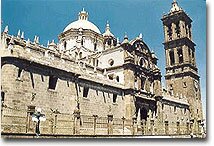
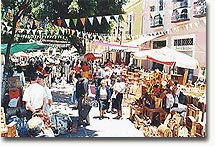

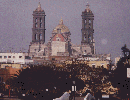 Cathedral |
The Cathedral was built in the XVIII Century, is one of the bigest from all over America, it has inside a wonderfull decoration. The Cathedral is one of the most interesting sites in the city.Ubication:"3 Oriente" Av. and "16 de Septiembre" St., "Centro Histórico".
|
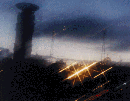 Los Santos Fountain |
This fountain represents the Welcome symbol to Puebla city. The fountain is built out of quarry stone that is a characteristic material in many other monuments of the city.UbicationAaron Merino Fernández Blv. and Juárez Av
|
 La calle 7 Poniente en el Centro Histórico
|
The streets at the downtown has many "Colonial" buildings from XVII and XVIII century with iron balcony and the front with ornamental tile and grass mat style brick walls.Ubication"7 poniente" av. between "16 de Septiembre" and "3 norte" st. |
 Ecological Park
|
This park was built in the old Air Field. This is a big lung for the city and a wonderfull place to take a walk. Into the park there is an aviary with the most important bird species from all the State of Puebla.
"24 Sur" street between "M.A. Camacho" avenue and "35 Oriente" avenue
|
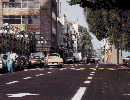 Zocalo |
Just in the down town is the Zocalo with it's gardens, monuments, and the famous "San Miguel" fountain. The big trees give a quiet and nice place to take a break. Ubication "M.A. Camacho" Av and "16 de Septiembre" St.
|
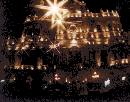 Palacio Municipal |
This Palace is the official city hall. The front is made out of stone brick and was built in the 30's. Inside the hall you should visit the "Salón de Cabildos". Ubication "M.A. Camacho" Av. and "2 Norte" street |
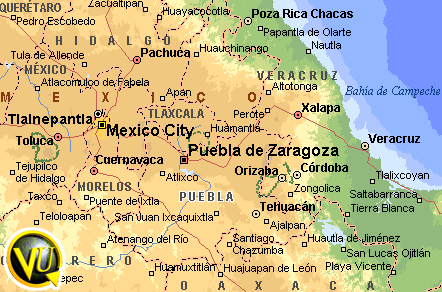
Tel: +1 (514) 844-2831 Fax: +1 (514) 844-2018 Email: